I love cities with a propensity for big, bold thinking. Some label it an “edifice complex,” I call it city-building. This is a lost art, often misunderstood by even the best-intended planners.

Cleveland became known as “The Mistake on the Lake” after a series of high-profile environmental disasters in the 1970s
Cleveland, Ohio – the “mistake on the lake” – is a city with such a propensity. The Fifth City, once an equal anchoring the Eastern Great Lakes half-way between Chicago and Toronto, nowadays the city has dropped off the world stage and settled into more of a regional role. There is nothing wrong with this.
Context – What is a Legacy City?
Ranks 10-40 are filled with cities that once claimed “Top 5” destination status (populations rounded to the nearest million).
- New York City-Newark, 23 million
- Los Angeles-Long Beach, 18 million
- Chicago-Naperville, 10 million
- Washington-Baltimore, 9 million
- San Jose-San Francisco-Oakland, 8 million
- Boston-Worcester-Providence, 8 million
- Dallas-Fort Worth, 7 million
- Philadelphia-Reading-Camden, 7 million
- Houston-The Woodlands, 7 million
- Miami-Fort Lauderdale, 6 million
- Atlanta-Athens-Sandy Springs, 6 million
- Detroit-Warren-Ann Arbor, 5 million
- Seattle-Tacoma, 4 million
- Minneapolis-St. Paul, 4 million
- Cleveland-Akron-Canton, 4 million
- Denver-Aurora, 3 million
- Portland-Vancouver-Salem, 3 million
- Orlando-Daytona Beach, 3 million
- St. Louis-St. Charles, 3 million
- Pittsburgh-New Castle, 3 million
- Charlotte-Concord, 2 million
- Sacramento-Roseville, 2 million
- Kansas City-Overland Park, 2 million
- Salt Lake City-Provo-Orem, 2 million
- Columbus-Marion-Zanesville, 2 million
- Indianapolis-Carmel-Muncie, 2 million
- Las Vegas-Henderson, 2 million
- Cincinnati-Wilmington-Maysville, 2 million
- Milwaukee-Racine-Waukesha, 2 million
- Raleigh-Durham-Chapel Hill, 2 million
- Nashville-Murfreesboro, 2 million
- Virginia Beach-Norfolk, 2 million
- Greensboro-Winston-Salem, 2 million
- Jacksonville-St. Mary’s, 1 million
- Louisville-Elizabethtown, 1 million
- Hartford-West Hartford, 1 million
- New Orleans-Metairie-Hammond, 1 million
- Grand Rapids-Wyoming-Muskegon, 1 million
- Greenville-Spartanburg, 1 million
- Oklahoma City-Shawnee, 1 million
(Rounded to the nearest million, cut-off at OKC #40 with 1.4 million)

Not to belabor the point, but scale is so important for “big thinking.” What may be thinking big in Jacksonville, with about 1.5 million in its metro, simply does not pass muster as the same in a city twice the size. As you see from the above list, despite being America’s 48th largest city proper (and falling, with 389,000 residents in its 77-square mile territory) – Cleveland is still pretty big. It is in fact America’s #15 metro. Even still. So while it has lost some of its luster, its important to not hyperbolize the fall of Cleveland. It has fallen from #5 to #15; it’s just less dense, more gentrified, and more suburban, hence the rise of Westlake, Mentor, Hudson, Medina, and around 500 other burbs…
New Orleans was once a Top 5 city as well, with its iconic Jackson Square named for the former president who first became a war hero in its vicinity fighting the French & Indian War. New Orleans has fallen a long way, from “Top 5” to #37. That is a city that just needs to maintain as something as world class as Vioux Carre, Uptown, Magazine Street, Tulane, and more are simply not possible in today’s metros of 1 million. New Orleans is blessed with a legacy that realistically its modern planning can never aspire to replicate. Heck, no city can ever replicate that. So toward that end, New Orleans is the classic “legacy city,” as defined by the famous Brachman-Mallach report on Regenerating America’s Legacy Cities.
Three Underrated Secrets About Cleveland
So the sky in Cleveland is not falling; it’s just a shade of gray 350 days out of the year. Cleveland has not dropped from #5 to #48. The function of Cleveland has changed. It’s no longer a nuclear entity. It is a hub for a larger region. For Ohio, it’s our state’s hub for bad sports (priorities, people), entertainment, banking, manufacturing, high tech, logistics, travel, research, and really practical stuff like that. It basically just lacks what Columbus has, that being government and education, and perhaps has also ceded shopping to Columbus (which is a retail HQ hub).
The first underrated fact: All of these functions (listed above) that Cleveland still dominates represent development opportunities past, present, and future.
The second underrated fact: Despite a legitimate decades-long “free fall” following the turbulent 1960s, Cleveland NEVER stopped building skyscraper cities. It’s a city that always thought big even when the hole was getting bigger. That is unique. Perhaps that’s an “edifice complex,” I don’t know.
The third underrated fact: While it’s never any one thing, if it has to be, the cause of Cleveland’s troubles was (and sadly continues to be) the racial inequality. The race riots were so incredibly damaging, with a legacy of despair that endures decades later in the hearts and minds of people. Cleveland was the #3 “receiving station” of the Great Migration, behind only Chicago and Detroit, and a topic I have researched extensively in a former gig at the Cleveland Restoration Society.
Putting all these facts together: Cleveland will always keep building, “under construction since 1798” as they say,” but it needs a foundation of community, and should that ever happen then Cleveland can really blossom. Working towards equality is work towards city-building.
Cleveland as a city, as envisioned by the founder of equity planning Norm Krumholz, is a beacon of refuge for the disenfranchised. Basically for all of NE Ohio’s disenfranchised. For better or worse, that is the City of Cleveland’s primary customer – those who have nowhere else to shop (so to speak).
Before Big Dreams, Big Nightmares
As a city that for better or worse has always “done it up big,” several factors have wreaked havoc on the city that exists today. Many of these factors have impacted other communities as well, but I can think of no other city adversely impacted by all of these issues, and sadly what makes Cleveland unique is the magnanimity of the adverse impact.
A few trends:
- De-industrialization
- Cleveland falls in the category of cities that have lost 43-56% of industrial jobs since 1950
- Foreclosure crisis
- Slavic Village, Cleveland’s inner-southeast neighborhood, was the #1 ZIP code (44105) for active foreclosures in 2007. This has led to the “Foreclosure Ground Zero” moniker. This one neighborhood had 787 active foreclosure filings at once. (!!!)
- Airline hub consolidation
- Cleveland has actually fared better without the United Hub, so take that
- Sports relocations
- Browns to Baltimore, then expansion team awarded (Browns return). These episodes really tear at the intangible bonds within a community, whether you’re pro-sports or not.
- Suburban sprawl
- NEOSCC / Vibrant NEO has assembled an incredible resource on Cleveland sprawl
- Urban renewal
- I.M. Pei. “Erieview.” East 9th Street. Need I say more?
- Race tensions
- In any city, the health of its people is going to manifest itself in the built environment. In Cleveland, 60% of its permanent residents are disenfranchised minorities. While its an extremely liberal and pro-diversity city, regressive policy at the state and federal level aims to push most Clevelanders around.
A visual representation of these trends:

I must credit Angie Schmitt for both this gif and the “America’s worst parking crater” moniker
Comeback City
Rising out of the literal wreckage of all of the aforementioned conditions and trends, and out of the psychological shadow that lingers long after the dust has cleared, is a city that never stopped building. The 950-foot Key Tower, the tallest between NYC and CHI, was built in 1991 at a time when you could have taken a nap in the middle of Euclid Avenue. The 660-foot 200 Public Square tower was built in 1985. The 450-foot One Cleveland Center was built in 1983. The 450-foot Fifth Third Center was built in 1992. The 430-foot Stokes Courthouse tower was built in 2002. All in all, from 1983-2002, these 19 years resemble some dark years – so that it comes as a surprise that the city built so much during this period. To be fair, this period also had several “false starts” of premature revitalization that failed to stick not unlike November snow.
We have now transitioned into a period where revitalization is in full force, heralded by the national media any time Cleveland is mentioned. These projects and this revitalization are now more like a January blizzard, with ground cover that (like it or not) is going to stick for a while. Perhaps until June.
Recently Completed (last 2-3 years)
I really want to get to the projects I see in the pipeline right now, but I couldn’t do that without mentioning just some of the major projects that still have that new project smell. It is these projects that inspire confidence in A, the staying power of this revitalization; and B, that proposed projects will come to fruition.

The 9 is a $170 million complex featuring an upscale Heinen’s grocery store in the historic AmeriTrust Rotunda. In the Marcel Breuer-designed brutalist AmeriTrust tower behind, there are high-end apartments, and The Metropolitan (A Marriott Autograph Collection hotel). Photo credit: The Plain Dealer

The Cleveland Clinic continues to build, but the Sydell-Miller Pavilion gave it a centerpiece. Also, the $500 million pricetag distinguishes it from most Clinic projects here and there. Photo credit: The Plain Dealer.

The Horseshoe Casino was a $350 million investment that revitalized the Higbee Building, which the Van Sweringen’s built to house the department store they felt their Union Terminal Complex needed.

MOCA, the Museum of Contemporary Art, was comparatively cheap at just $27 million, but leverages the impact of its really cool design to make a splash

The $250 million University Hospitals (CWRU) Seidman Cancer Center
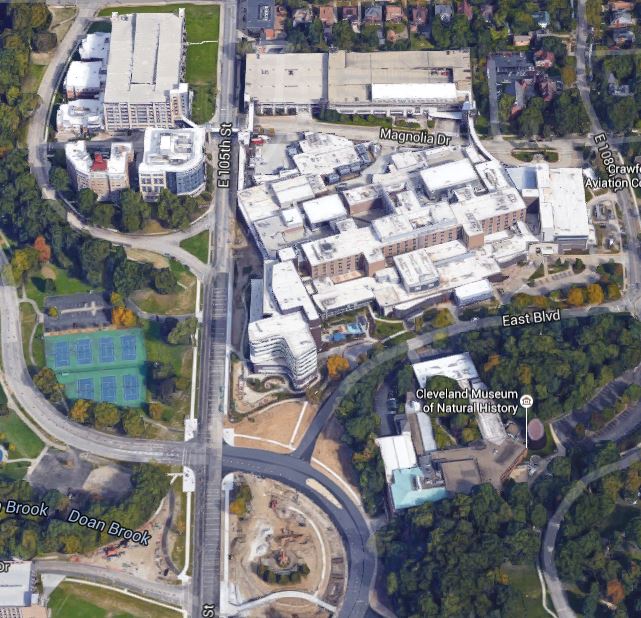
The $525 million Louis Stokes VA Hospital campus. Finished 2014.

PlayHouse Square exterior improvements. Again, at “just” $16 million, doesn’t really meet the threshold for this list, if only it weren’t all spent on design that really makes an already-incredible district pop. Pictured: The world’s largest chandelier (hanging over Euclid Avenue)

Battery Park, the $100 million redevelopment of the former Eveready Battery factory complex in Detroit-Shoreway, will feature mostly lakefront condos (330 units). The old power plant has been restored into a wine bar.

In Tremont, the Gospel Press factory has been rehabbed into 102 lofts. Before functioning as a printing press for bibles this complex was the short-lived “University of Cleveland,” that was replaced by Fenn College, which eventually became Cleveland State University. (I may have over-simplified that sequence a little)

The Tudor Arms, rehabbed into a Doubletree in 2011, is even more incredible inside. As a historic tax credit projects, this $20 million investment went a long ways. Typically historic rehabs realize huge cost savings, at least if something large-scale and high-quality is your end goal.
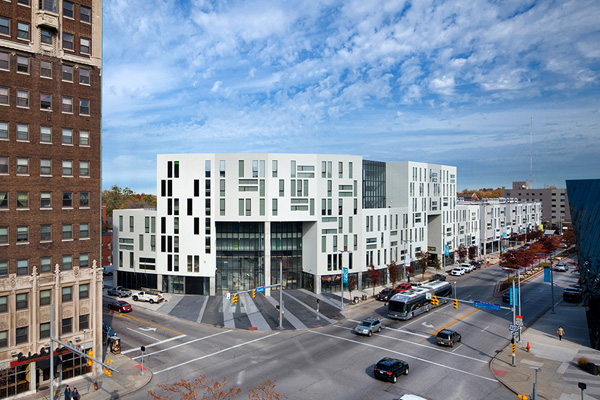
I used to park on this site when I first moved to Cleveland in 2012. And into 2013. Finished 2014. This $65 million project features roughly 200 high-end apartments, dorm spaces for Cleveland Institute of Art, as well as street-level retail including Barnes & Noble, a bowling alley, Panera, Constentino’s grocery store, restaurants, and bars. This was a New Markets Tax Credit project (Constantino’s is a QALICB).
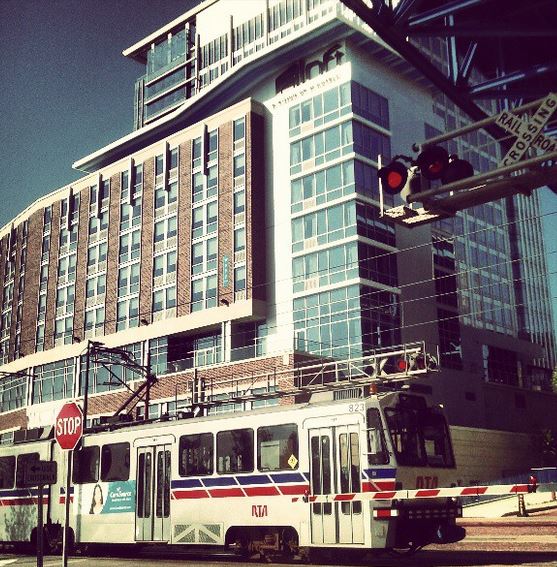
The $92 million, 330-foot, 23-story Ernst & Young office tower has brought activity back to the Waterfront Line (light rail, pictured). Photo rights reserved by me.
Coming UP
Now we get to the exciting part – as Cleveland continues to reach higher, plan bigger, and execute better – these are the projects either under construction or moving through the proposal process. This is the next wave of progress that is set to come crashing down, in a good way.

Overall, the Flats East Bank project is a $500 million vision. Phase 1 was the $100 million EY tower + Aloft. Phase 2 mostly completes the project, and brings the residential, retail, restaurant, and entertainment component. This pic from @Clevelandgram on Instagram, progress as of two weeks ago.

UC3, or University Circle City Center, will add 700 mixed-income apartments including a high-rise component. The project anchors the southern terminus of Rockefeller Park, opposite the Wade Lagoon in front of the CMA.

nuCLEus: $300 million, 54-story, 650-foot tall tower. The “jenga” connector, which is a 4/5-story “bridge” cantilevered between the two smaller towers and the base of the main tower. 500 apartments, 400,000 SF of office (leases already signed, lead-tenant will be Benesch Law Firm), and 140,000 SF retail arcade. This WILL happen. Not just because they’ve already secured financing, but also because of developer Bob Stark’s track record, which includes Crocker Park in Westlake.
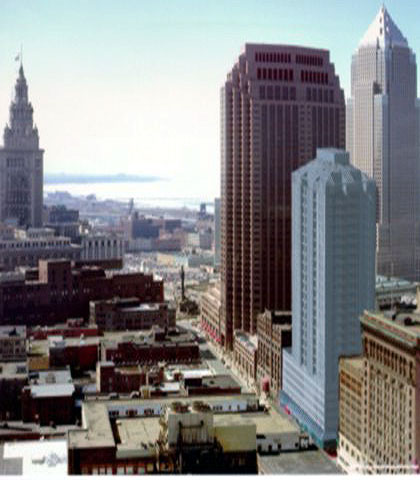
Bob Stark is also proposing to add apartments, pictured below, atop the garage at E. 6th and Euclid. This is a bit more tentative, and probably gets built after nuCLEus.

Weston and Citymark, two of the biggest names in the suburban Cleveland real estate market, just last week proposed this $100 million behemoth on the above-pictured “World’s greatest parking crater.” Yes, those parking lots that separate the Warehouse District from Public Square/Tower City. When finished this will encompass 1,200 apartments and 3 million SF, broken into two phases.
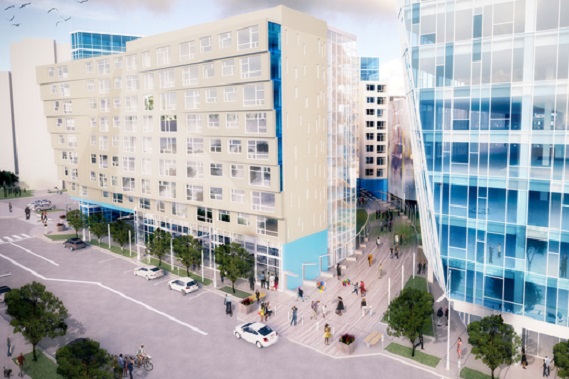
Intesa, a $100-110 million proposal by Coral and Panzica, is proposed to flank the new Mayfield Road Red Line (light rail) station between Little Italy and University Circle. With 700 parking spaces, 300 micro-apartments, and tech incubator office space – this project will complement the adjacent light rail. If it ever gets off the ground.

One University Circle is a $112-million, 20-story, 240-foot luxury condo tower. This project, downsized from 28-stories at first, is taking the site of the Cleveland Children’s Museum, which has to relocate first.

As great as all of these projects are, what Cleveland really needed was a $270 million RNC Convention Hotel. Actually it’ll be great because this 380-foot, 32-story, 600-room hotel will enable to Cleveland to continuously bring in top conventions.

Lakefront development proposed for the North Coast Harbor site, surrounding the Rock & Roll HOF and Browns Stadium, could total $280 million, 1,000 apartments, in addition to office and restaurants.

The $32-million redesign of Public Square, consolidating the four blocks into two that function better as one (only buses allowed through). This is one of the public investments making all of this private investment possible.
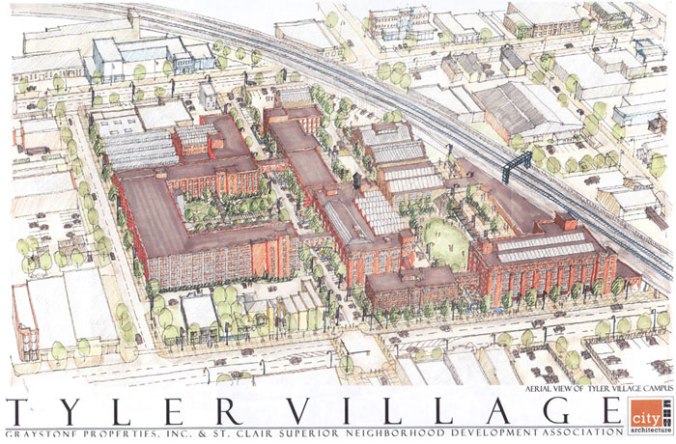
Tyler Village, the mixed-use revitalization of a factory complex in St. Clair-Superior, will yield 450 new apartments. Underway currently.
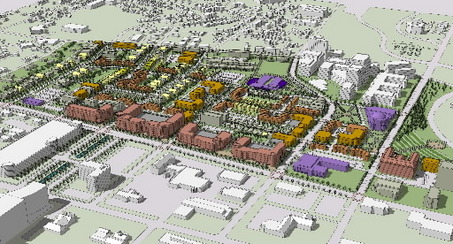
Upper Chester, by the Finch Group working in tandem with other developers, will fill in the gap between University Circle, Midtown, the Clinic, and Hough. This projects responds differently to the context on all four sides. The $42 million first phase is complete, and the next phase of build-out (three altogether) should start soon. The coolest phase will be the restoration Newton Avenue, a tiny little cobblestone road with cute little wooden homes. Many other developments would demo this street, rather than blending it into a new development.
Whew.
That was exhaustive, and in the event anyone actually read all of that, congrats for making it this far. Isn’t it incredible how this “dying city” is thriving?
What is even more impressive – all of the smaller projects that connect the neighborhoods to these business districts and corridors.
There is still a disconnect between population growth (or lack thereof) and all of these projects. I am not sure what is happening as there are many different theories. One, “gentrification” is reducing densities in some neighborhoods that really were too dense (for instance, imagine a Tremont house subdivided into an 8-plex during the dark years, now rehabbed into a single home or double).
Undoubtedly, the “good news” is still mostly confined to a growing list of neighborhoods where investment is concentrated. The truth is that the NE Ohio market is always hungry for new product, and rather than more stuff in Beachwood/Westlake stuff is finally happening in Cleveland – but that doesn’t translate into a market for Cleveland’s roughest neighborhoods. There is still a “tale of two cities,” and while downtown Cleveland’s population is set to surge north of 20,000 in the next 5 years (just counting everything under development for certain), the east side is still hemorrhaging population. The truth is many minority families are now moving out into the southeastern suburbs like Warrensville, Bedford, etc – much in the same way that Poles/Ukrainians/Russians in Tremont moved straight south into Parma/Independence/Seven Hills. Black flight won’t be all that different than white flight, sadly.
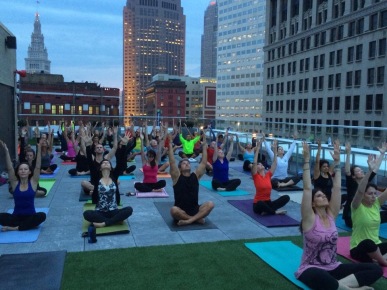
Urban revitalization isn’t much different than yoga. You gotta be able to enjoy the view, move into seated downward fold, and breath out – all at the same time.
However, for a city with challenges and opportunities just like any other – you have to be able to stretch your strengths and minimize your weaknesses. You have to fight for growth where the market works and fight to save neighborhoods where the market doesn’t work. You have to be able to walk and chew gum at the same time.
Note: Post taken from my first WordPress, the Eurokie blog.

































